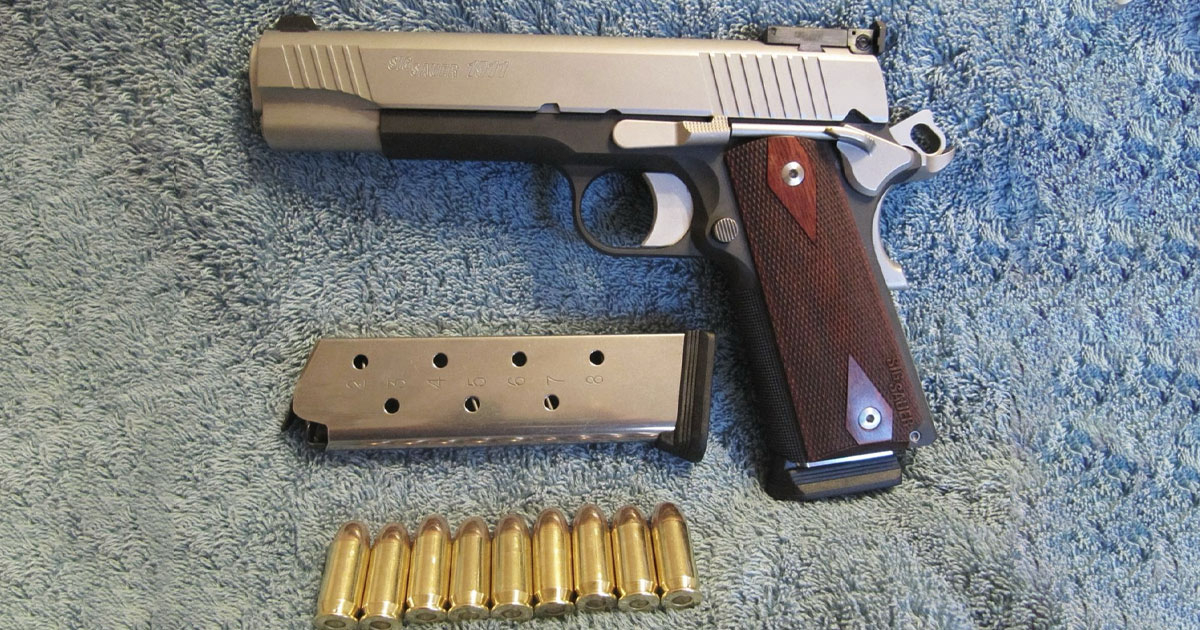Magazine Disconnects: Are They Necessary for Your Pistol’s Safety?

This week, a national reporter contacted me to set up an interview for a story on pistol magazine disconnects and safeties, which NBC News will publish. We had our interview, and this friendly reporter was very thorough and asked some controversial questions for the story. I was glad to help her and share my opinions about this interesting subject since she was ambiguous about some ideas and had incomplete information. I want to share some of our discussions about this interesting subject and my opinions here. Safety first is always my prime goal.
What is a Magazine Disconnect Feature for Pistols?
Some semi-automatic pistols (handguns that automatically eject and load cartridges in the chamber after every shot fired) have a magazine disconnect feature. This feature does not allow the firearm to fire when the magazine is not present or is disengaged. It renders a handgun inert with the mag removed. The disconnect feature is an internal mechanism that engages a mechanical safety, such as a trigger block or trigger disconnect, when the firearm’s mag is removed.
Removing the magazine pivots a lever at the rear of the magazine well forward, which moves the trigger bar out of alignment with the sear and prevents the pistol from firing. Reinserting the mag realigns these two parts, permitting the gun to be fired by a standard trigger pull. Note that customers can order some pistols with or without the mag disconnect.

Deciding Your Preference for Mag Disconnect
When deciding about your mag disconnect preference, it is important to consider your primary use of the gun, e.g., self-protection, concealed carry, home defense, duty gun-LEO or military, range shooting, competition, casual plinking, etc. A few of my fun range plinking guns (older models) have magazine disconnects, e.g., Browning Hi-Power, Ruger Mark III, Ruger SR9, and Ruger LC9s. Most Smith-Wesson 3rd-generation pistols do.
California is the only state that requires handguns to have both a chamber load indicator and a magazine disconnect feature. California also requires that all new semi-automatic pistols be equipped with costly and not technically proven microstamping technology. Massachusetts, Maryland, and California require childproofing technology for pistols in 2024.
A safety argument against a mag disconnect is that if an extractor fails or, for other reasons, a round remains in the chamber, the gun will unexpectedly become “hot and live” when someone reinserts an empty magazine later. With a magazine disconnect, depressing the trigger to clear the gun or pointing it in a safe down-range direction to clear it will not clear the round in the chamber because the trigger is disabled. When an empty magazine is inserted the firing system becomes reactivated, even though the trigger has been previously depressed. Some say a gun without a magazine is useless except as a club.
Recognize that if you take the mag out and do not seat it fully when reinserted or your mag becomes unseated during firing or a deadly force situation, you have an inoperable weapon. It may take a moment to figure out what the problem is. Under stress, some folks take more time to respond, and actions may not be optimal, so lives may be on the line.
The Ruger MK III has a mag disconnect and it is hard to insert and remove magazines and it makes the trigger a little heavier. This is not a prime candidate for a concealed carry or self-defense handgun. The mags do not drop freely when you press the release button. These issues are not present in the MK IV’s.
Point:
The Sporting Arms and Ammunition Manufacturers’ Institute stated an “obvious concern with magazine disconnect features is that determining whether the gun is safe becomes linked to the presence of the magazine as opposed to actually checking the gun, opening the action, and ensuring it has no ammunition.”
Point:
Just because a mag is removed from a pistol does not make it safe since a round may still be in the chamber. Know how to properly safety check a firearm.
Accidental, Unintentional, or Negligent Discharges & Safety
Know how to safely handle and use your specific handgun for your given purpose. It may not be as important in range shooting or fun plinking, but it is very important in self-defense or the use of a duty pistol. It depends on your use, your training, and your personal preference. However, knowledge of your specific handgun is paramount for safety and performance.
What about magazine disconnects as a safety against accidental discharges? First, I believe that there are NO accidental discharges, but rather negligent discharges, as I told the NBC News Reporter. What I mean is that so-called “accidents” happen because shooters are negligent and do not know, or do not follow safety rules and procedures. If you know the four basic safety rules and procedures and their importance to your handgun operations and safety, you are prepared and can prevent accidents from happening by applying the rules and procedures. I believe this is especially true for beginners with no formal safety and handgun training, with little practical application experience with their specific gun, and with no formal training in safety rules.
Modern semi-automatic pistol designs do not allow firing the gun without a trigger press. Unintentional discharges without a trigger press are simply not credible, given the documented extensive and rigorous testing conducted by handgun manufacturers, the U.S. military and federal law enforcement agencies, and other military and law enforcement agencies around the world. There are extremely rigorous testing by manufacturers and guns “conform to standards” of the National Institute of Justice (NIJ), the Sporting Arms and Ammunition Manufacturers’ Institute (SAAMI), and other federal and state agencies. Of course, there are civil court cases where individuals have tried to challenge pistols firing without the trigger being pressed or activated by some force. Improper or unsafe handling of the pistol by the individual has proven to be one of the most common causes of unintentional discharges.
Point:
For a pistol to fire, the trigger MUST be pressed or activated by some sufficient force. Based on my research and experiences, no one, including court “experts,” has ever been able to replicate a handgun discharging without a trigger press. Properly designed handguns cannot fire without their triggers being depressed by an individual’s finger or foreign object.
Point:
It is the responsibility of each shooter/gun handler to know the features of their specific gun and to handle it safely, to explicitly know the basic safety rules, the proper safety check procedure, and safe shooting, handling, and storage of their gun.
Experts say the risk of unintentional discharges tends to be greater for law enforcement officers because training often instructs them to keep a round chambered in their duty weapon, which they often wear on their hips throughout the day. However, this does not relieve them of their responsibility to handle and use their handgun safely.
Safety Lessons Learned to Help You
After many years of teaching handgun essentials and safety to military, law enforcement, and civilians and witnessing shooters’ negligence in operating handguns safely, I believe that no device or feature intended as a safety measure replaces hands-on actual use experience, respect for and handling of a firearm, and personal development and knowledge of safety rules. Proper personal firearms handling and rules applications should ALWAYS be the primary safety considerations.
Point:
There is no mechanical gun feature nor safety device that substitutes first for the individual’s knowledge and application of proper safety rules and procedures. Trust yourself through knowledge and proper safety applications, not in a mechanical tool that will break or malfunction at some point.
Point:
Sadly, over many years of handgun teaching and classes, I have discovered that the most common pistol safety mistakes are “finger on the trigger when it should not be” and “not first removing the magazine (before inspecting the chamber for a round) when safety checking a pistol.”
4 Basic Gun Safety Rules
The best safety on any firearm is you, the user, and your brain and thinking. Know and strictly follow proper safety rules and procedures.
1. Always Keep Firearm Pointed in a Safe Direction
Never point your gun at anything you do not intend to shoot. This is particularly important when loading, unloading, or cleaning a firearm. In the event of an accidental or negligent discharge, no injury can occur as long as the muzzle is pointing in a safe direction.
2. Treat All Guns as Though They Are Loaded
You should develop this safety habit as an automatic response. Always open the action immediately when you handle a firearm or hand it to someone. First, remove the magazine, and then visually and physically check the chamber to be sure it does not contain any ammunition. Always keep actions open when not in use. Never assume a gun is unloaded. Check it for yourself, no matter the experience or trust level of the one who made the gun available to you. This is considered a mark of training and knowledge of an experienced gun handler.
3. Keep Your Finger Off the Trigger Until You Are Ready to Shoot
Never touch the trigger on a firearm until you intend to shoot and have your eyes and sights on the target. Keep your trigger finger on the frame, off the slide, and away from the trigger while loading, unloading, cleaning, or checking a room for an intruder. Never pull the trigger on any firearm with the safety in the “safe” position since it is possible that the gun can fire at any time, or even later, when you release the safety, without you ever touching the trigger again. Of course, this depends on the specific gun model. Ideally, a gun is designed to fire when you press the trigger and only then, but no design is perfect, especially for older guns. Glock firearms, for example, used to have a problem with their firing pin being floating, so they could sometimes fire when dropped or hit just right. It was rare, but it was possible then. Many modern guns since the 1990s have a safety feature in the trigger that requires you to apply a fair amount of pressure to actually make it fire (around 6 pounds or so), and just dropping it is usually not enough. If you’re just holding the gun at rest, it’s pretty much impossible to just go off on its own.
Recognize that different guns have different trigger press weights. For example, a Beretta 92FS (M9) typically has about an 11-pound double-action trigger press with a 6-pound single-action press. Professional shooters for competitions will typically modify their guns for a much lighter trigger press of about 3 to 4 pounds. This is, quite obviously, riskier than having a heavier trigger press, but these kinds of guns are not being used for self-defense and are used mainly at a shooting range or under a controlled environment. The average trigger press for pistols is about 6 pounds, with between 4 and 7 pounds of force applied for a shot. In most scenarios, you are not going to apply that force in the right direction if the weapon is dropped to make it fire. Thankfully, most modern firearms have a Firing Pin Safety, a Trigger Safety, or both that keep the gun from accidentally firing.
If you practice the safety guidelines of (A) never pointing the gun at someone, (B) never putting your finger on the trigger unless you are ready to shoot, and (C) always treating the gun as though it is loaded, the chances of a shooter accidentally shooting someone drops to next to nothing.
4. Always Be Sure of Your Target and What’s Beyond It
Don’t shoot unless you know where your shot will land. Ensure your bullet will not injure anyone or anything beyond your target. Know that even a .22 short bullet can travel over 1 1/4 miles, and a high-velocity cartridge, such as a .30-06, can send its bullet more than three miles. Remember how far a bullet will travel if it misses your intended target or ricochets in another direction.
Why I Prefer No Mag Disconnectors for Self-Defense Guns
For my concealed carry and self-defense guns, I prefer a pistol not to have a mag disconnector because if I need to fire a shot when performing a reload with the mag out and a round is in the chamber, I can. This is called a Tactical Reload and is done when the gun is not empty, and there is a round left in the chamber. It is about speed in a stressful situation and having sufficient rounds available quickly. Some prefer a Tactical Reload since it leaves the self-defense shooter with a one-shot gun for the shortest period of time.
What if the mag release lever or button is inadvertently pushed by an attacker, and the mag drops? Or do you have a mag disconnector that does not allow the gun to fire when the mag is out? In a deadly-force situation, you still want the pistol to fire. But when range shooting at targets or fun plinking, it does not matter since the paper target does not shoot back.
As a trained and knowledgeable adult in proper handgun safety and use of my gun, I know and follow the safety rules and procedures when handling and operating my gun. So when I press the trigger, it is because I need or want to and have a very good reason for doing so… like defending my life or the lives of others. A mag disconnect feature on my pistol limits me and does not give me the options I need in a deadly-force situation.


Most modern pistols already have adequate mechanical safeties built in, so a mag disconnect is superfluous and inconvenient. Today, a very high number of pistols include a Loaded Chamber Indicator (or option for one), which clearly shows if there is a round in the chamber. Many contemporary pistols routinely have active safety devices, like Trigger Safeties, Firing Pin Safeties, Drop Safeties, in addition to Manual Safeties. Note that all 1911 pistols have Manual Safeties. And double-action revolvers have no Manual Safeties by design. Remember, a Manual Safety does not make a gun safe, nor does the lack of a Manual Safety make a gun inherently dangerous. The real key to avoiding negligent and unintentional discharges is to know and follow the universal rules of firearms safety.


and Firing Pin Block-Drop Safety
Examples of Safeties
All my 1911-style pistols have both Manual and Grip Safeties. My Springfield SA-35, Kimber Micro-9, Sig P938, and Smith-Wesson M&P Shield Plus pistols have Manual Thumb Safeties. Many of my pistols have Trigger Safeties and Loaded Chamber Indicators. The Springfield Hellcat Pro that I am currently reviewing has a Loaded Chamber Indicator, a Trigger Safety, a Firing Pin Safety, and a Drop Safety. My Springfield XD-M has a Grip Safety, a Trigger Safety, and a Loaded Chamber Indicator. Recent Glock models use a Safe Action Trigger system, which includes a Trigger Safety, a Firing Pin Safety, and a Drop Safety. The Ruger GP100 has a thumb safety and a built-in Transfer Bar Safety to prevent accidental discharge. There are no mag disconnectors on my Glocks, Springfields, CZ, FNH, Kahr, Taurus, Magnum Research, STI, or Sig pistols. Note that there are variations by models.
For untrained users, added weight, clunky mag disconnectors with potential failures, and even Manual Safety can slow the user down in high-stress situations, and mistakes with inaccurate or delayed trigger presses may cost them their lives. So know your handgun, how it functions, and the types of safety it has, and apply the safety rules. Train and practice often.
Negligent Discharges When Cleaning Firearm
Several people have discharged their firearms while cleaning them, having thought the gun was unloaded and the chamber clear. This is preventable by knowing and applying the basic gun safety rules and procedures, especially the safety check procedure. You have to wonder if someone cannot properly unload or safety check a gun, if they even know and follow the basic safety rules and procedures, and how they can possibly safely clean the gun.
Point:
When performing a proper safety check for any pistol, remember to remove the mag first and then check that the chamber is empty, in that order.
Proper training in basic gun safety rules, the proper safety checking procedure, and thoroughly knowing your specific handgun will avoid this preventable negligent discharge problem. If you own a gun, you have a major responsibility to yourself and others to know the gun safety rules and properly apply them.
11 Types Of Mechanical Handgun Safeties
- Manual Safety Lever
- Grip Safety
- Drop Safety
- Firing Pin Block or Striker Block – Blocks firing pin from prematurely hitting round, e.g., Ruger Max9- No Mag Disconnect and has Striker Block & Loaded Chamber Indicator
- Hammer Block
- Transfer Bar – Ruger GP100 has thumb safety and a built-in transfer bar to prevent accidental discharge
- Safety Notch
- Trigger Safety- Is de-activated as a natural result of the shooter firing the gun but is engaged in most other circumstances. The trigger is composed of two interdependent parts, and the shooter moves both parts of the trigger to fire the gun. Unintentional pressure, a drop, or a strike against the trigger is unlikely to activate it, so this will not fire the gun
With a Trigger Safety, a lever sticks out from the trigger face and must be fully depressed to disengage a lock that allows the main trigger body to move. Unintentional pressure against the top of the trigger without pressing the lever does not disengage the lock, and the trigger will not move. This design has many moving parts and is advantageous because accidental pressure on the lock release requires more force to press the main trigger. Glocks, for example, have multiple safeties built in, like Trigger Safeties and Striker Bar Safeties. None have Mag Disconnects.
Trigger Safeties, for example, are included on Glock 19, Ruger 57 & Security 9, Springfield XDM, S&W CSX & M&P (has Trigger/Firing Pin/& Disconnect safeties), Beretta APX, Walther PPQ, and Canik TP9 Elite.
- Decocker- Allows the hammer to be dropped on a live cartridge without risk of discharging it, usually by blocking the hammer or retracting or covering the firing pin before releasing the sear. This eliminates the need to press the trigger or control the hammer’s fall.
- Loaded Chamber Indicator- Raised indicator above ejector port and slide
- Magazine Disconnect
Conclusions
You and your knowledge and application of safety rules and procedures are the best safety any gun can have. Better than any mechanical safety, which can and does fail. So firearm safety is up to you. Be responsible for safety yourself. Take a handgun training class and learn the rules of safety and the basics of shooting safely. Follow safety procedures and develop safe shooting habits. By following the basic safety rules and gun safety check procedure, you negate the need for a magazine disconnect feature. Using a magazine disconnect as a safety against an individual’s inattentiveness, not knowing safety rules and procedures, and not strictly adhering to them will only mask the problem rather than solve it. Altering or adding pistol mechanical ‘hardware’ to address a personal knowledge and application/use problem is the wrong approach. It’s a mechanical HARDWARE ‘solution’ to a user problem, which is the wrong approach to solving the problem.
Remember, the best safety on any gun is the individual shooter and his/her brain and thinking. Any mechanical “safety” is a piece of metal that can and will break, and its use builds complacency and trust in a tool that should not be trusted. Trust yourself through safety knowledge and its proper application for your specific gun, not in a tool that will break or malfunction at some point.
Unintentional gun discharges are rarely a design flaw or the gun’s fault but are human performance errors of negligent discharges. Modern semi-automatic pistol designs do not allow firing the gun without a trigger press. Almost all modern pistols have built-in safeties, like Trigger and Firing Pin Blocks and Loaded Chamber Indicators. Improper or unsafe handling by the individual is one of the most common causes of unintentional and negligent discharges. Not using proper safety-check procedures and limited knowledge of safe gun handling rules and safety procedures are the real culprits.
Based on my research and experiences, no one, including court ‘experts’ in trials, has ever been able to replicate a handgun discharging without a trigger press. Properly designed handguns cannot fire without their triggers being depressed with sufficient force in the correct direction by an individual’s finger or foreign object.
Those who claim unintentional discharges without a trigger press are simply not credible, given the documented extensive and rigorous testing conducted by handgun manufacturers, the U.S. military, federal law enforcement agencies, and other military and law enforcement agencies around the world.
Be safe, get trained in the universal Safety Rules and Procedures, properly apply them, and practice and practice some more.
SUCCESS and SAFETY FIRST!
Photos by Author.
This personal opinion article is meant for general information & educational purposes only, and the author strongly recommends that you seek counsel from an attorney for legal advice and your own personal certified weapons trainer for proper guidance about shooting & using YOUR firearms, self-defense, and concealed carry. It should not be relied upon as accurate for all shooters & the author assumes no responsibility for anyone’s use of the information and shall not be liable for any improper or incorrect use of the information or any damages or injuries incurred whatsoever.
© 2024 Col Benjamin Findley. All Rights Reserved. This article/review and its images/pictures may not be reprinted, reproduced, or distributed in whole or in part by mechanical means, photocopying, electronic reproduction, scanning, or any other means without prior written permission. For copyright information, contact Col. Ben Findley at [email protected].
Read the full article here







